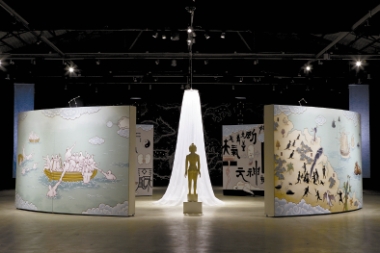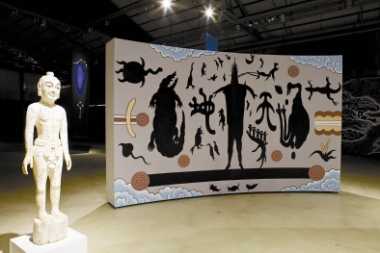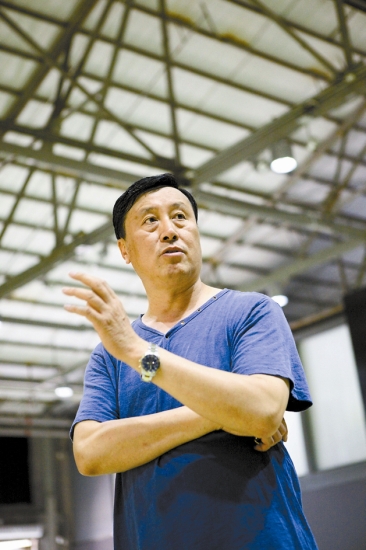|




Newman Huo, Zhu Linglin
A MAN sends an e-mail to his lover, telling her that he was happily driving his car and listening to music when he started thinking about Einstein and Hollywood films. Suddenly, it started thundering and began to rain heavily. The car broke down. The man got stuck in the forest and felt unhappy. So now he is finally telling her that he misses her and loves her…
This is the story which Guan Wei, one of the renowned Chinese artists living in Australia, said he had tried to tell in his work “Modern Codes.”
The work is a part of the “Spellbound — Guan Wei 2011 Solo Exhibition at OCAT,” which will be held at the OCT Contemporary Art Terminal (OCAT) in Overseas Chinese Town, Nanshan District, from April 30 to June 15.
“‘Spellbound’ is a metaphor for the fate of the universe, a civilization or a specific people who repeatedly run in circles,” said Guan, 54.
“Man is burdened with this fate, wandering around among different cultures, pacing back and forth in a world full of allure, only to end up back where he began,” he said.
“So the overall thinking behind the exhibition is to present a progression of movement, flow and return to the point of origin,” he said.
The exhibition is presented in three rings of circular wall paintings at the 1,300-square-meter OCAT exhibition hall.
The first ring, with the theme “Constellation Map,” comprises four main inside walls of the exhibition hall, representing stars of the cosmos, ancient creation myths, the mysterious Milky Way and constellations.
The second ring, with the theme “Kaleidoscopic World,” is painted on the outside of four round walls in the middle of the exhibition space, representing land, sea and islands, and its mysterious flora, fauna, boats, and people, as they seek out their homelands in confusion and fear.
The third ring, with the theme “Mysterious Symbols,” is painted on the inside of four round walls, representing mysterious symbols, ancient signs, incantation rune, divination marks, DNA encoding, and various products of mankind’s inner perceptions.
“The three rings correspond with heaven, earth and humankind, and the concentric rings create a cyclical, repeating ‘spell,’” said Guan.
As the largest work Guan has created in recent years, the three rings of circular wall paintings reach a total area of 486 square meters.
The huge work draws comprehensively from various sources, such as Chinese folk divination, symbolic folk runes, constellations of Islamic and Western culture, navigational markers, Australian aboriginal cave paintings, and symbols of modern technology.
“Emigration, traveling, migration, roaming and wandering through multiple cultures cause the visual juxtaposition, transformation and fusion of multiple cultural images,” Guan said.
Born in Beijing in 1957, Guan graduated from the department of fine arts at the Capital Normal University in 1986.
He took part in China’s modernist art movement in the 1980s. Upon immigrating to Australia in 1989, he began melding the cultures of Australia and China, exploring the circumstances and diverse potential of different civilizations against the backdrop of globalization.
Using epics, legends, mythological narratives and grand spaces, his artworks present an image of the world which juxtaposes history and reality, experience and transcendence, conflict and confluence. His reserved, humorous style gives his works an air of effortlessness as he tackles these substantial topics.
Guan has appeared at various important international exhibitions, such as the Asia Pacific Triennial and Shanghai Biennial, either as an independent artist or a representative of Australia. He has spent much time moving back and forth between Australia and China in recent years.
“After drifting through different cultures, and getting lost and pacing about in this alluring world, you will discover you are still in your own cultural loop, and you have once again returned to your point of origin,” Guan said.
The artist along with four of his assistants from China and Australia has completed a massive fresco at the OCAT exhibition hall this month. Most of the artwork will be destroyed when the exhibition is finished.
The exhibition is sponsored by the Australian Embassy in China and the Australian Consulate in Guangzhou, and has been listed as a key project in the “Year of Australian Culture.”
Dates: April 30-June 15
Hours: 10 a.m.-5:30 p.m. Closed Monday
Add: OCT Contemporary Art Terminal, Enping Road, Overseas Chinese Town (华侨城恩平路OCT当代艺术中心)
Metro: Hua Qiao Cheng Station (Overseas Chinese Town Station 华侨城站), Exit A
|

